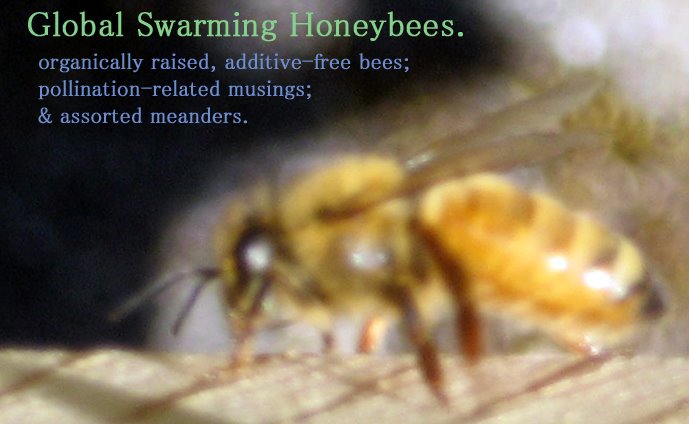Our friend Eva recently returned from an amazing trip to New Zealand. Along with penguins, sheep, flowers, mountainsides, starfish, and Roberta Flack (!!), Eva encountered some lovely bees and bee-imitators (a.k.a. "wannabees"). With her permission, we're sharing some of her images here. Can you tell the real bees from the bee mimics?
3.17.2009
Bees (and Wannabees) of New Zealand
7.29.2008
Recent Things












6.04.2007
Hummingbird Moth (Mad Honey, Anyone?)
The pinxter (an amazing native azalea) has been in glorious blossom all week, attracting dozens of bumblebees and Eastern Tiger Swallowtails. It's also attracted one of my favorite insects, the hummingbird moth, which mimics the green coloration of the ruby-throated hummingbird, hovers and maneuvers like a hummer, and even hums like a hummer with its rapidly beating wings. You can see why this moth is also known as the "Common Clearwing."

Check out that proboscis!
Here you get a sense of the moth's hummingbird-like stance and flight pattern.

Proboscis to the flower, the hummingbird moth sips the pinxter's nectar. The plant gives off a wonderful sweet-peppery scent. Doesn't seem to attract the honeybees, though. They're off working the remains of the horse chestnut blossoms, the many hawthorns in bloom, and the very first blackberry blossoms of the season. I've read that the azalea flower's shape does not facilitate easy nectar-gathering for honeybees, and based on the length of the hummingbird moth's proboscis compared to the honeybee's, that makes sense to me.
I've also read that if honeybees DO gather azalea nectar in large quantities, the resulting honey can be toxic to humans (though safe for bees). Honey produced from rhododendron, mountain laurel, and azalea forage is called Mad Honey and is both psychoactive and poisonous (so you hallucinate and then die? I dunno. I don't want to find out.).
While I am glad our honeybees aren't gathering from the pinxter, it occurs to me that herein might lie a viable pathway to a honeybee revolt against the array of human-sponsored abuses these amazing creatures are being forced to endure. The honeybees have a right to be mad; maybe it's time they went on strike and started producing Mad Honey for awhile, until we stop treating them like mechanical objects, and start showing a little respect.
5.18.2007
"Dangling Swamp-lover!"
Sounds like something Robin would exclaim in the last 30 seconds of a Batman episode, but actually it's a cool little fly that protects itself by looking a lot like a bee.
Just as soon as the snow stopped and the crocuses bloomed, the honeybees were on the case, working those blossoms and gathering pollen.
This critter (to right of honeybee) made an appearance, too. Athough I couldn't find it in my Audubon Society Field Guide to the Insects, a quick Google search of "honeybee mimic fly" brought me to photos of Helophilus pendulus, a type of hoverfly whose scientific name, according to wikipedia, means, "dangling swamp-lover."
One of the things I am enjoying about beekeeping is how it's opening my eyes to other insects. Everytime I see something in bloom now, I'm on the lookout for interesting pollinators, as well as for "my" honeybees. The bees are also introducing me to new botanical nuances, like the concept of nectar flow and a greater appreciation of pollen.








